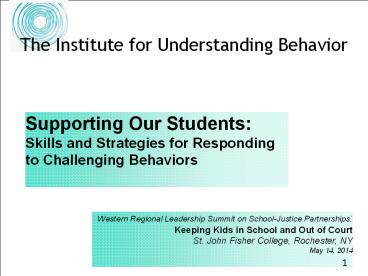The Institute for Understanding Behavior - PowerPoint PPT Presentation
Title:
The Institute for Understanding Behavior
Description:
The Institute for Understanding Behavior Supporting Our Students: Skills and Strategies for Responding to Challenging Behaviors Western Regional Leadership Summit on ... – PowerPoint PPT presentation
Number of Views:95
Avg rating:3.0/5.0
Title: The Institute for Understanding Behavior
1
The Institute for Understanding Behavior
Supporting Our Students Skills and Strategies
for Responding to Challenging Behaviors
Western Regional Leadership Summit on
School-Justice Partnerships Keeping Kids in
School and Out of Court St. John Fisher College,
Rochester, NY May 14, 2014
2
The Institute for Understanding Behaviora
progressive and preventative approach for New
York City Educators
- The Institute for Understanding Behavior is a
joint initiative created by the United Federation
of Teachers with the NYC Department of Education
to help schools ensure that every child develops
the social, emotional, and academic skills they
to succeed in school and in life.
3
The Influence of Educators
- Why do educators need an approach that is
preventative and proactive? - What types of challenges are our students facing?
How do they affect behavior in schools? - What is approach of the IUB?
- How can it help us support students?
4
The Institute for Understanding
BehaviorOverview of Action Plan for All
Participating New Schools The IUB requires a
3-Year commitment to help a school meet the goals
outlined below. However, we believe that many
benchmarks can be reached by the end of year 1
with full collaboration from the school.
- 3-Year Outcome Goals
- Reduction of suspension rates
- Lower occurrence of level 1 and 2 incidents
(preventing levels 3, 4, 5) - Improved attendance rates
- Increased academic achievement
- Use of data to support students and school
community - Effective Behavior Leadership Team
- School wide positive behavior support systems in
place - Decreased incidents of staff injury and violence
- Lower incidence of staff turnover
- Positive change in Quality Review, Progress
Report and Learning Environment scores - Enhanced social/emotional competence in staff and
students - Self-sustaining practices
- Deliverables
- 4-Day Therapeutic Crisis Intervention Training
for ALL school based staff - Weekend professional development retreat for up
to 10 faculty members and follow-up conferences
each year - SWIS (School Wide Information Systems) Licensing
and Training - Direct School Support by IUB Behavior Specialist
- Data Analysis Supported by External Evaluator
- Workshops in Understanding Childrens Mental
Health, Executive Functioning, Team-teaching,
etc. - Ongoing Professional Development in Areas of
Identified Need - Support Connecting to Community Based
Organizations - Ongoing Consultation with IUB Team on Using
School Data to Meet Action Plan Goals. - Training for All new Staff in TCIS When Hired
5
(No Transcript)
6
How do You Cope?
- What are some coping strategies that you use to
deal with stress? - Listen to the scenario, visualize that this is
happening to you. - What are you feeling now?
- What do you feel like doing?
7
A Crisis Occurs When
- A Students Inability to Cope Results in a Change
in Behavior
8
The Goals of Crisis Intervention are to
- SUPPORT environmentally and emotionally to
reduce stress and risk - TEACH students better ways to cope with stress
9
Stress Model of Crisis
10
Recovery Phase
11
Skills Building PyramidSelf-Awareness
12
Discussion about Self Awareness
- What situations do you find difficult in your
work? What behavior on the part of the young
person might trigger a stress response in you? - What self-regulations skills do you use?
13
What does Assessment Really Mean?Four Questions
We Ask Ourselves to Assess Crisis Situation
- 1. What am I feeling now?
- 2. What does this student feel, need, or want?
- 3. How is the environment affecting the
student? - 4. How do I best respond?
14
Effects of Anger
When we are at our angriest, we are at our
stupidest.
15
How Do I Best Respond?
- Manage the environment to neutralize potential
triggers - Engage the student and provide emotional support
- Exercise self-control over feelings
16
Feelings, Needs and Behaviors
Behaviors Feelings Needs
17
Assessing Behavior
- All behavior has meaning.
- Behavior reflects needs.
18
What Effects Behavior?Setting Conditions
- Anything that makes challenging behavior more or
less likely to occur. - Organizational culture, e.g., control oriented,
poor communication - Environment, e.g., hot, crowded, noisy, too much
visual stimulation - Instruction, activities, routines related, e.g.,
staffing, quality of instruction, activities - Personal, e.g., illness, medication, trauma
history, feeling unsafe - Relationship-based, e.g., excessive controls, us
versus them culture, lack of caring community
19
Treat Each Student As an Individual With
- Individual baseline behavior
- Different strengths and abilities
- Specific effects of trauma
- Underdeveloped co-regulation and self-regulation
skills - Possible physical discomfort, e.g., illness,
medication - A need for an individualized crisis management
plan (ICMP) or safety plan
20
Identifying A Students Needs
- What is this individual students baseline
behavior? Is this typical behavior? - Is this normal for a student of this age?
- Does this behavior reflect the students or
familys worldview? - Is this a pain-based behavior related to past
trauma? - What feeling is the student expressing?
- Does the student feel safe?
21
Meaning in Emotional Communication
22
Power Struggle
23
We Can Avoid or Stop the Power Struggle by
- Using positive self-talk
- Listening and validating feelings
- Managing the environment, e.g., removing others
- Giving choices and the time to decide
- Redirecting the student to another positive
activity - Appealing to the students self-interest
- Dropping or changing the expectation
24
(No Transcript)































